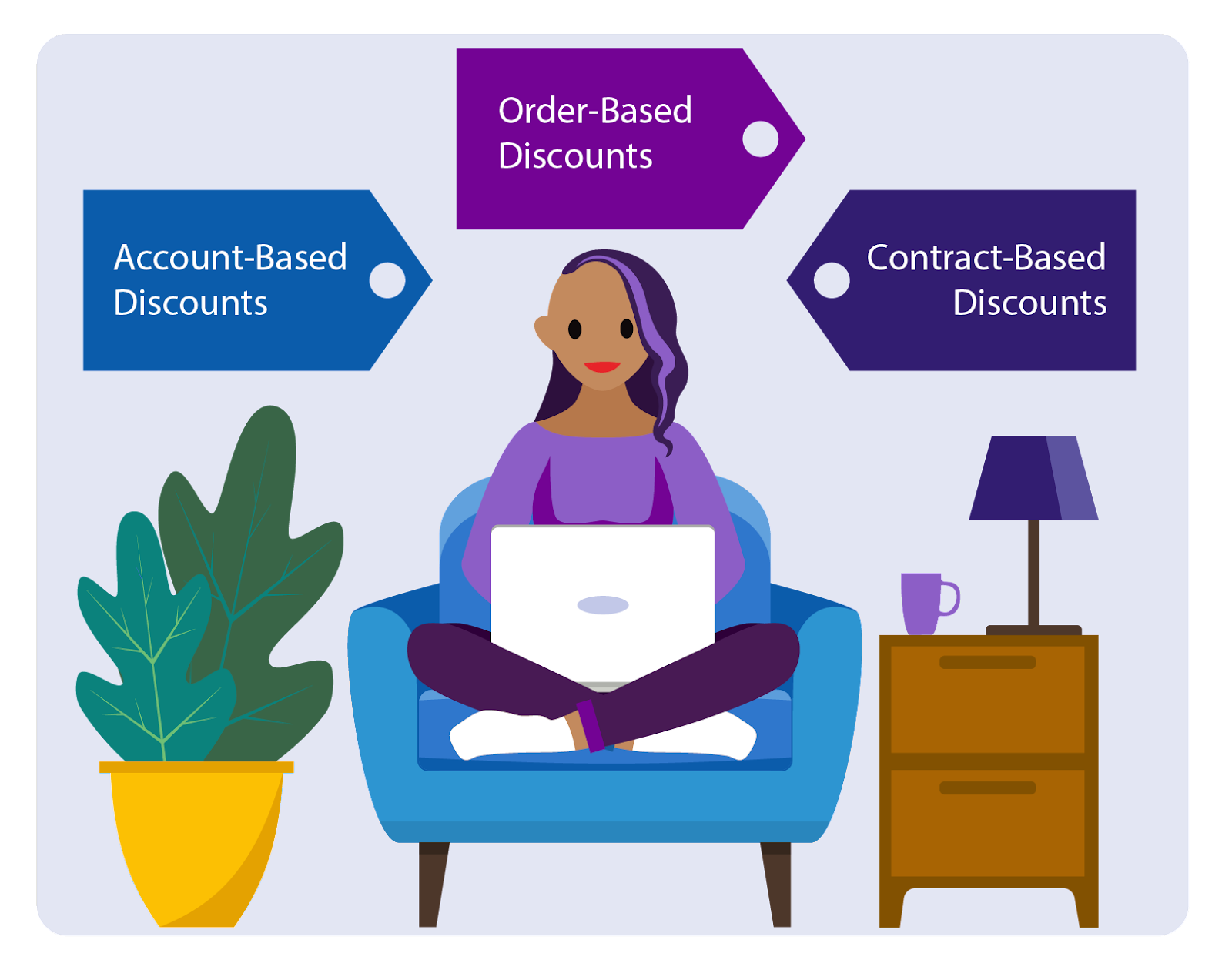割引について理解を深める
学習の目的
この単元を完了すると、次のことができるようになります。
- 割引とは何か、またその使用方法を説明する。
- 割引の 3 つの種別を挙げる。
- カート内での割引の使用方法を簡潔に説明する。
- 割引の削除方法を説明する。
割引の使用を始める
プロモーションは、Ada が期間限定で価格を調整し、Infiwave の収益を生み出す優れた方法であることがわかりました。割引はもう 1 つの値下げ方法で、次に使用します。
- 商品または商品カテゴリ
- 商品カタログ全体
- カート内の個々の品目
- カートの内容すべて
割引は、割引率 (Infiwave Phone 10 に適用される 20% 値下げ) または割引額 (価格から 15 ドルオフ) で指定できます。
商品チームがカタログ内の割引を設計して作成します。割引を適用した後、お客様に合わせて手動で調整できます。カート内でカスタム割引を作成して適用するオプションもあります。では、割引でどのようなことができるのでしょうか?
- 割引を定義して、特定の取引先や取引先責任者にリンクされた将来の注文に適用する。
- 提供する割引額または割引率、取引先または取引先責任者に対して割引が有効な月数、終了日、適用される販売カタログなどを編集する。
- 販売カタログ内の商品や商品グループ (すべての電話付属品など) に割引を適用する。
- カート内で新しい割引を作成する。
割引の種別
CSR が割引を利用するには、その割引が有効であり、CSR が作業している見積や注文の選択済み価格リストに関連付けられている必要があります。CSR が状況に応じて適切な割引を選択できるように、割引にはルールが関連付けられている場合もあります。

Industries CPQ には、注文ベース、取引先ベース、契約ベースの割引があります。詳しく見てみましょう。
注文ベースの割引
注文ベースの割引は、特定の商品、商品のコレクション (販売カタログなど)、またはカート内のすべての品目に対して購入時に適用される 1 回限りの割引です。これは、追加商品を購入してもらうために、お客様の購入意欲を刺激する優れた方法です。販売取引をより多く成立させるために、Infiwave の CSR はお客様にすべての電話付属品の 20% 割引を提供します。
取引先ベースの割引
取引先ベースの割引は、将来の割引のために取引先に保存され、割引の有効期限が切れるまで、次回以降の購入に適用されます。
取引先ベースの割引は、ロイヤルティとリテンション (L&R) プログラムの一環としてロイヤルカスタマーを維持するための優れた方法です。たとえば、Acme は Infiwave とすべてのインターネットサービスの 15% 割引を交渉しました。交渉済みの割引は Acme の取引先に保存され、Acme の今後の注文では、インターネットサービスに 15% 割引が自動的に適用されます。
契約ベースの割引
契約ベースの割引では、契約で指定された割引を見積や注文に適用します。契約には、交渉済みの条件を定義する、対応する枠組合意が含まれている場合があります。枠組合意を使用すると、商品レベル、カテゴリレベル、取引先レベルの割引を設定し、将来の販売の価格設定を促進できます。
たとえば、Acme は、従業員が Infiwave Phone 商品を購入するときに、すべての付属品が 5% 割引となるように Infiwave と交渉します。この割引は Acme の取引先に保存され、従業員が Infiwave Phone 商品をカートに追加すると自動的に適用されます。
カート内で割引を使用する
割引は、個々の商品、商品のコレクション、またはカート内のすべての商品を値下げする便利な方法です。数ステップで事前作成済み割引を追加して編集したり、カスタム割引を作成したりすることもできます。
ほとんどの割引はシステム管理者が作成し、CSR がカート内で [Add Discount (割引を追加)] ボタンをクリックすると表示されます。
![[Qualified Discounts (適格割引)]、[Disqualified Discounts (不適格割引)]、[Applied Discounts (適用済み割引)] が表示されている [Apply Discount (割引を適用)] ウィンドウ。](https://res.cloudinary.com/hy4kyit2a/f_auto,fl_lossy,q_70/learn/modules/industries-cpq-promotions-and-discounts-exploration/dive-into-discounts/images/ja-JP/8b31cdb703fb5e63a67eea6019448a70_use-discounts.jpeg)
[Apply Discount (割引を適用)] ウィンドウが開き、[Qualified Discounts (適格割引)] と [Disqualified Discounts (不適格割引)] という 2 つのタブの下に利用可能な割引がすべて表示されます。さらに、カートにすでに適用されている割引は、[Applied Discounts (適用済み割引)] の下に表示されます。割引の横にある [Add (追加)] をクリックするだけで、割引を注文に適用できます。
定義済み割引がビジネスシナリオに合わない場合、販売カタログ内の商品セットに対してカスタム割引を作成できます。また、必要に応じてカスタム期間を指定してカスタム割引額を割り当てることもできます。保存すると、カスタム割引はカートの [Discounts (割引)] タブに追加されます。
割引を削除しなければならない理由は、却下だけではありません。間違えた場合や、最初からやり直す必要がある場合もあります。理由は何であれ、割引はいつでも削除することができます。注文のカートワークスペースから [Applied Discounts (適用済み割引)] セクションで割引のアクションメニューを選択し、[Delete (削除)] をクリックします。割引が [Applied Discounts (適用済み割引)] リストから削除されます。
割引承認
デフォルトでは、割引は見積および注文プロセスで自動的に承認されます。ただし、組織に割引承認プロセスがある場合、割引承認ボタンがカートに表示されます。また、割引を含む新規の見積と注文の承認状況は [Required (必須)] となります。
割引の承認が必要な場合、カートの注文の上部に警告が表示されます。[Request Approval (承認を申請)] をクリックすると、承認状況が [Pending (未承認)] に変わります。割引が承認されると、注文を送信する準備が整います。注文状況は [Activated (有効)] に変わります。割引が承認されなかった場合、状況は [Rejected (却下)] に変わります。この注文でさらにアクションを実行するには、割引を修正するか、削除する必要があります。
次のステップ
Ada はプロモーションと割引について理解しました。次は Back to School Student Offer (新学期学生オファー) に適した価格調整を決定する必要があります。次の単元では、適切な価格調整を選択します。
リソース
- Salesforce ヘルプ: Types of Discounts in EPC (EPC の割引の種別)
- Salesforce ヘルプ: Approve Discounts in Industries CPQ (Industries CPQ での割引の承認)
テストのシナリオ
Ada は、携帯電話付属品の価格を 20% 値下げする注文ベースの割引を作成しました。この割引により、Infiwave の CSR は注文取得時に販売を促進することができます。Ada は Infiwave の割引承認プロセスも設定しました。不満を抱き、サービスをキャンセルしたがっていたお客様を覚えていますか? CSR は、お客様に満足していただくためには 20% では不十分だと感じ、割引率を 25% に引き上げたいと考えています。
